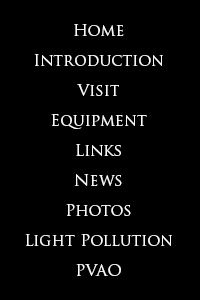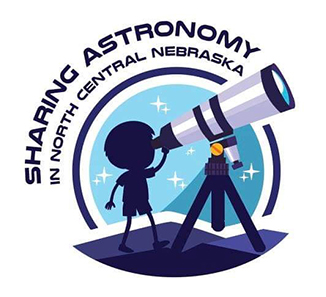




Merry Christmas!

Play Christmas
Jazz!
It's "Time" To Come and Visit Us!
(Whatever That is :)

Videos For The Current Month Are Provided As Soon As They Become Available.
Turn Off The Sound At The Top
Of This Page To Listen To These Videos!
(The Width of a Full Moon is Roughly 1/2 Degree.)
Download This Month's Star Charts Here
Our viewing sessions for November had to be cancelled due to weather. We'll try again for 2 dates this month and hopefully get one of them to work. Make sure to dress warmly! Bring a chair/chaise lounge to sit on along with a warm beverage - especially for meteor viewing this month! Viewing dates for December are below on this page.
In case of viewing session cancellation, I put out messages on the observatory email listserv and text lists. If no one reserves for a viewing session, I may opt for another activity at home. Please call or email instead of just showing up. If you wish to be added to the e-mail and/or text list, e-mail me at mark.urwiller@gmail.com. If you want to be on the text list I need your phone number and cell provider. These services are free and free of ads/spam!
Please note these sessions are cancelled if the sky conditions/weather are not good. What does that mean? Well, (optical) telescopes can't see through clouds! It will need to be almost perfectly clear. The next potential problem is wind. If the wind velocity is much more than about 10 mi/hr - that's too much! A telescope magnifies the size of the objects we view - and the effects of the wind! Lastly, is the issue of mud or snow (winter). The last stretch of road to the observatory is not maintained.
Please check the ClearSkyClock and weather links on the home page of this site! What if you're in doubt the observing session will take place? If it's not perfectly clear and calm, you can call (308) 293-5776 before leaving for the session!The observatory has a cell phone adapter for scopes and binoculars. Before you get too excited, please note that cell phones are somewhat limited as to their astronomical capabilities. You won't be able to photograph the "faint fuzzies" we put in the scope. However, you will be able to leave with a photo of the moon or a planet :) This unit features a bluetooth remote shutter so there is no shake to activate the shutter. Come out and give it a try!
From O'Neill Nebraska take US HWY 281 north to Road 883. Turn left (west) 2 miles to 490 Avenue. Turn right (north) 0.6 mile to the red gate. Proceed north of the gate another few hundred feet.
You will see the entrance on the right. We will have you park along the fence near the entrance. Be advised there is a barb wire fence around the building location. If young children are present, they need to be watched. Please call or e-mail to register so we know how many people to plan for!

Dec 19th at 7:00 PM - Dark/Deep Sky Observing. There are plenty of objects to view including Saturn and the Andromeda Galaxy. Orion will be rising in the East. We'll use the main observatory telescope along with a smart telescope to take some photos.

If you would like to make reservations, call us at 308-293-5776 before 9:00 PM daily or contact by e-mail.
We look forward to seeing you!

When visiting the observatory, here are some
rules/recommendations you should consider:
1) Please stay in or close to the observatory. This
facility is located on private property, which is not mine. Please
show your thanks to the owners by keeping the area clean and
undisturbed.
2) Please, while in the observatory, don't touch anything unless you ask
and/or have been instructed as to the proper use of the instrument!
3) Bring a lawn chair for each member of your group, that is if you plan
on staying a while, as we hope you will. If it is clear, please keep in
mind that it often takes a while to find objects for you to look at.
Often there are others in line to see these things as well. You are welcome to pull up a chair and ask as many questions as
you like. We have some chairs, but not many.
4) Bring a flashlight for dark-sky observing sessions! (If the moon
is in the sky, you may not need it.) You will need one of these to
safely navigate from your car to the building. We purposely don't have
any lights in the area of the facility. Once in the building, we
generally ask that you don't use your flashlight (with its white bulb)
unless you ask. We have red lights which will help you see where you are
going inside the building!
5) No smoking is allowed in or around the building!
6) In winter, please bring plenty of warm clothing! This can't be
over stressed. Standing still in the cold is nothing like being active
in it! Wear several layers and don't forget those gloves/mittens and
something for your head. There is no such thing as glamour when it comes
to staying warm! There is no heat in the observatory!
7) In Summer - don't forget the mosquito repellant!
8) Be advised there are no bathroom facilities in the observatory!
9) No boisterous behavior within the observatory, or around it, will be
tolerated!
10) The observatory now has a permanent barbed wire fence to keep
the cattle out. Please don't let kids get near it!

![]()
Worried about the threat of light pollution in your area? For more information on it and how you can help educate others to enjoy lights AND the night sky - check out our light pollution page and the link page!
 Send comments to:
mark.urwiller@tutanota.com
Send comments to:
mark.urwiller@tutanota.com
Keep Looking Around!

Mark Urwiller - Web Page Administrator
Home Introduction Visitation Dates Observatory Equipment Links
Observatory News Photos Light Pollution PVAO